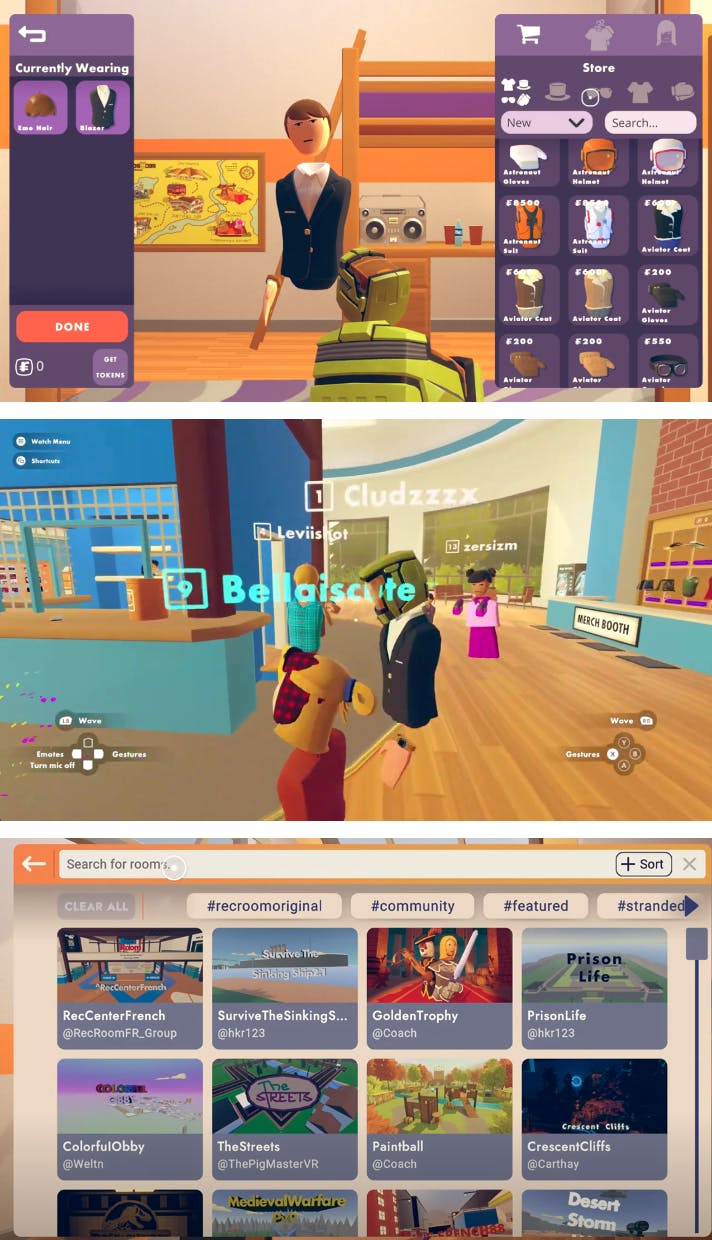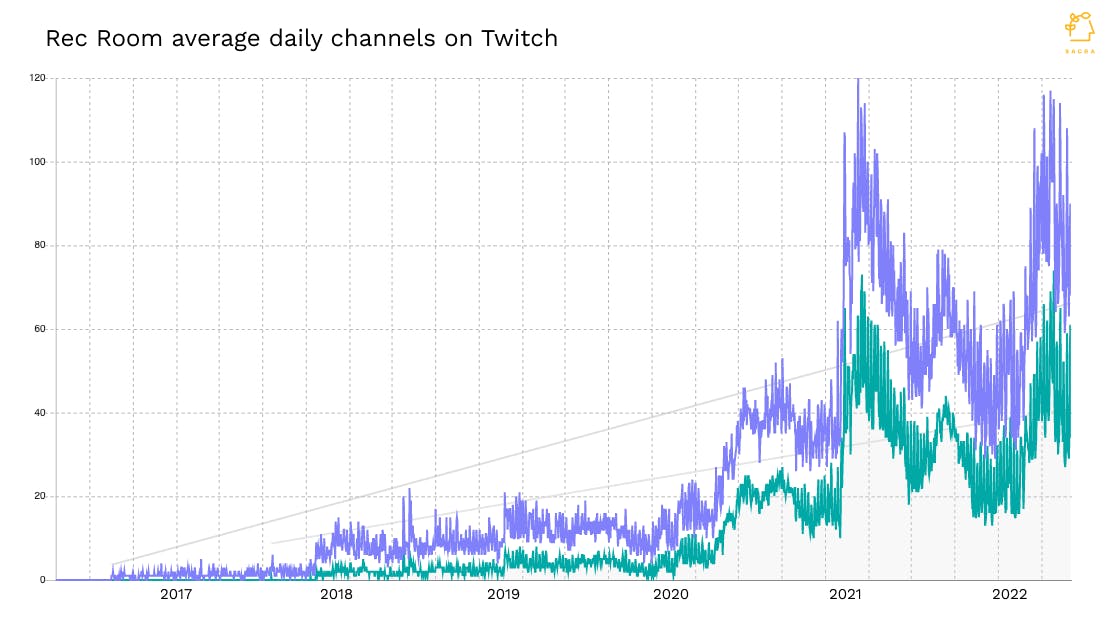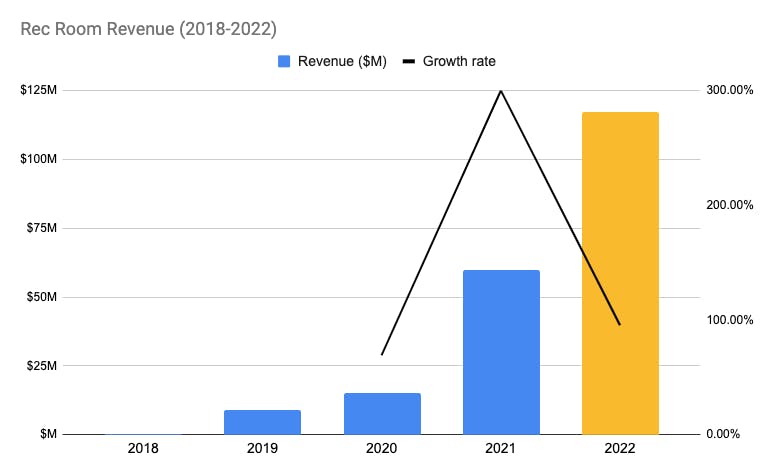
Revenue
$117.00M
2022
Valuation
$3.50B
2022
Growth Rate (y/y)
95%
2022
Funding
$349.04M
2022
Valuation
Rec Room has achieved a valuation of $3.5 billion based on its most recent funding metrics. The company has raised a total of $294 million to date from prominent investors. Key backers include Sequoia Capital, Coatue Management, and Index Ventures, representing some of the most established venture capital firms in the technology sector. The company's funding has been supported by additional investors including Madrona Venture Group and Greycroft.
Product
Rec Room is a gaming company building the “Roblox of VR” that lets users interact, explore, and play games in player-created rooms.
Rec Room is more of a platform for VR games and experiences than a videogame itself. Users customize their virtual avatars, meet and chat with other players in the lobby-like Rec Center, and then jump into different player-designed rooms with them.
Some rooms are designed more like traditional games, from PVP (player versus player) games like ^armadilloPVP (a take on Red Dead Redemption) where players fight and interact in a Western setting, to suspenseful, story-driven experiences like TheBackroomsAllSeeing.
Others are more laid-back—like CrescentCliffs, where users hang out and casually parasail without objectives, or VerifiedStudioV2, where aspiring musicians can sing and perform for others.

From top to bottom: Rec Room’s avatar designer, hanging out in the Rec Center, and choosing a room
Rec Room launched in 2016 with six pre-built games like paintball, disc golf and paddleball—essentially “Wii Sports for VR”—available on Steam VR.
Since then, Rec Room has expanded to many VR and non-VR platforms, including Windows, PS4, PS5, Oculus Quest, Oculus Quest 2, iOS, Xbox One, Xbox Series X/S, and Android. 37 million people have played Rec Room across 12 million player-created rooms across all platforms.

Rec Room’s growth took off with the onset of COVID, with their average daily Twitch channels almost immediately tripling. Opening the platform up to more platforms continued that growth.
After their 2021 growth, we estimate that Rec Room has about 23 million monthly active users (MAUs) and 760K daily active users (DAUs). That’s about 76x as many as Meta’s Horizon Worlds VR project, which was 300,000 monthly users. Console and VR users spend around 2.4 hours per day in Rec Room, comparable to Roblox’s 2.6 hours per day.
Rec Room started off as a free-to-play platform, but like Roblox, introduced features allowing users to charge others in-game currency to sell their own items and a subscription service (Rec Room Plus) that offers discounted in-game currency and other perks.

Given the similar business models, we used information from Roblox’s public filings to benchmark Rec Room’s revenue. Roblox had a stable monetization rate of about $5 per MAU until 2021—assuming similar for Rec Room, we get $60M in revenue for 2021 and a run rate of $117M for 2022 as of March.
The company has raised $294M, most recently raising $145M from Coatue with participation from Sequoia Capital, Index Ventures, and Madrona Venture Group.
Competition
Rec Room competes with other multiplayer, multi-platform and online games like Roblox, as well as VR platforms like VRChat and Meta’s Horizon Worlds.
Against these games, Rec Room is positioned as an end-to-end consumption and creation experience where the creation of new in-game assets itself occurs in-game, whereas designing assets for e.g. VRChat requires spending time in a game design engine like Unity. In Rec Room, by contrast, users can collaborate with others in-game, voice chat, etc. while building. In addition, Rec Room players can create across platforms, while Roblox and VRChat creators are limited to creating on the PC versions of the games.
Rec Room has been moving away from VR as a defining feature of the product and positioning itself for more direct competition with games like Roblox, perhaps in response to VR’s lack of growth and traction with their core audience. According to the Piper biannual teen survey, 17% of teenagers who own a VR headset use it once a week, and only 5% use it every day.
TAM Expansion
There are a few key tailwinds and future growth opportunities worth considering for Rec Room:
Metaverse investment
Big companies like Meta and Microsoft are prioritizing metaverse projects like Quest, Horizon Worlds, and AltspaceVR. Companies related to the metaverse raised about $10B in 2021. Global spend on VR/AR is expected to hit $72.8 billion by 2024. And the more attention that is brought to the space by big companies, startups and investors, the more it will benefit early entrants into the category like Rec Room (founded in 2016).
User growth
Roblox and Minecraft are two of the biggest games in the world today. Roblox alone has about 200 million MAUs and pulls in nearly $2B of revenue per year. But the natural dynamics of stagnation and decline in the gaming industry mean that Rec Room has a massive opportunity to pick up players of these games who become burned out on the mechanics, community, or want a novel experience.
Non-gaming and B2B use cases
Rec Room has announced its ambitions to move into older age brackets and non-gaming use cases like weddings, family reunions, company retreats and more. And we’re seeing signs that the kind of VR/AR gaming pioneered by Roblox and Rec Room may be catching on with older people: as of November, more Roblox users are over 13 than under 13, and according to their S-1, 30% of the player base is over the age of 17.
Funding Rounds
|
|
|||||||||
|
|||||||||
|
|
|||||||||
|
|||||||||
|
|
|||||||||
|
|||||||||
|
|
|||||||||
|
|||||||||
|
|
|||||||||
|
|||||||||
|
|
|||||||||
|
|||||||||
|
|
|||||||||
|
|||||||||
| View the source Certificate of Incorporation copy. |
News
DISCLAIMERS
This report is for information purposes only and is not to be used or considered as an offer or the solicitation of an offer to sell or to buy or subscribe for securities or other financial instruments. Nothing in this report constitutes investment, legal, accounting or tax advice or a representation that any investment or strategy is suitable or appropriate to your individual circumstances or otherwise constitutes a personal trade recommendation to you.
This research report has been prepared solely by Sacra and should not be considered a product of any person or entity that makes such report available, if any.
Information and opinions presented in the sections of the report were obtained or derived from sources Sacra believes are reliable, but Sacra makes no representation as to their accuracy or completeness. Past performance should not be taken as an indication or guarantee of future performance, and no representation or warranty, express or implied, is made regarding future performance. Information, opinions and estimates contained in this report reflect a determination at its original date of publication by Sacra and are subject to change without notice.
Sacra accepts no liability for loss arising from the use of the material presented in this report, except that this exclusion of liability does not apply to the extent that liability arises under specific statutes or regulations applicable to Sacra. Sacra may have issued, and may in the future issue, other reports that are inconsistent with, and reach different conclusions from, the information presented in this report. Those reports reflect different assumptions, views and analytical methods of the analysts who prepared them and Sacra is under no obligation to ensure that such other reports are brought to the attention of any recipient of this report.
All rights reserved. All material presented in this report, unless specifically indicated otherwise is under copyright to Sacra. Sacra reserves any and all intellectual property rights in the report. All trademarks, service marks and logos used in this report are trademarks or service marks or registered trademarks or service marks of Sacra. Any modification, copying, displaying, distributing, transmitting, publishing, licensing, creating derivative works from, or selling any report is strictly prohibited. None of the material, nor its content, nor any copy of it, may be altered in any way, transmitted to, copied or distributed to any other party, without the prior express written permission of Sacra. Any unauthorized duplication, redistribution or disclosure of this report will result in prosecution.